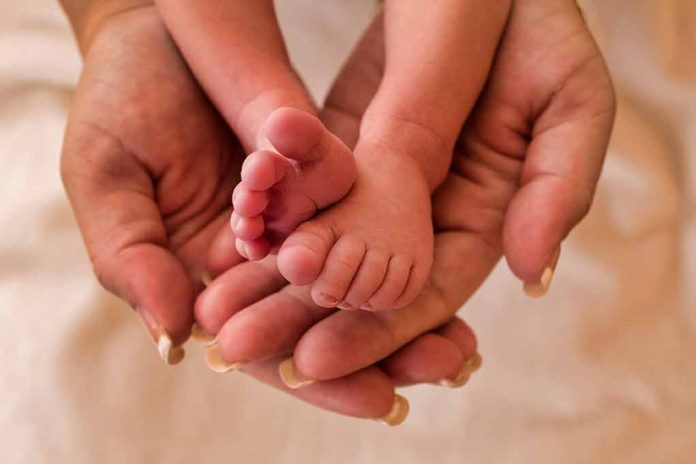
President Trump backs $5,000 “baby bonus” to counter America’s declining birth rates, but critics question whether the one-time payment is enough to convince families to have more children.
Key Takeaways
- The Trump administration is considering a $5,000 cash incentive for new mothers to boost America’s declining birth rates, which hit their lowest point since 1979 last year
- Additional proposals include allocating 30% of Fulbright scholarships to married applicants or those with children and implementing educational programs about menstrual cycles
- The initiative draws inspiration from Hungary’s family incentive system, although critics note Hungary’s birth rates haven’t significantly increased despite similar programs
- Some experts argue the $5,000 bonus is insufficient compared to the estimated $23,000 annual cost of raising a child
- The policy aligns with conservative values emphasizing family as society’s cornerstone and has support from right-wing think tanks like the Heritage Foundation
Trump’s Proposed Family Incentives
The Trump administration is exploring a series of policy initiatives aimed at reversing America’s declining birth rates, with a $5,000 payment to new mothers as the centerpiece proposal. When asked about the idea, President Trump expressed his support, stating, “Sounds like a good idea to me,” according to multiple sources. The plan represents a targeted effort to address what some conservatives view as a demographic crisis, with 2023 recording the lowest number of births since 1979 and the average American family now having fewer than two children.
Beyond the direct financial incentive, the administration is considering additional measures to promote family formation. These include reserving 30% of prestigious Fulbright scholarships for married applicants or those with children, and launching educational programs about menstrual cycles and ovulation to help women who want to conceive. Policy experts and advocates have been meeting with White House aides to develop comprehensive strategies encouraging larger families, though officials have not yet decided which specific plans to implement.
JUST IN: President Trump is considering issuing a $5000 baby bonus for mothers to increase birth rates, according to the New York Times.
The White House is reportedly coming up with strategies to tackle declining birth and marriage rates.
In addition to the $5000 baby bonus,… pic.twitter.com/V6ZaVtD3d9
— Collin Rugg (@CollinRugg) April 22, 2025
The Hungarian Model and Its Limitations
The Trump proposal draws inspiration from Hungary’s family incentive system, which offers substantial tax benefits and loan forgiveness for families with multiple children. Hungary’s program includes tax deductions and credits for each child and eliminates income tax entirely for mothers with four or more children. Despite these generous incentives, critics note that Hungary has not seen a significant increase in birth rates, raising questions about the effectiveness of financial incentives alone in addressing complex demographic challenges.
“A $5,000 baby bonus is wasteful and won’t make a dent, especially among middle to upper class families,” said commentator Maggie Anders.
Anders further criticized the proposal as negligible wealth redistribution with unclear goals. She highlighted that the average cost of raising a child in America is approximately $23,000 annually, making a one-time $5,000 payment insufficient to meaningfully influence family planning decisions.
The Administration’s Broader Family Focus
White House Press Secretary Karoline Leavitt emphasized that the administration “is proudly implementing policies to uplift American families.” She added that “The President wants America to be a country where all children can safely grow up and achieve the American dream.” The fertility initiative aligns with conservative values that position the family as society’s cornerstone, a principle outlined in Project 2025, a conservative policy blueprint. The Heritage Foundation, a prominent right-wing think tank, has been actively involved in discussions about increasing birth rates and researching causes of infertility.
“Collapsing birth rates will cause any species to go extinct,” warned Elon Musk, a vocal supporter of pro-natalist policies who has claimed that “humanity is dying” due to declining birth rates.
The administration’s focus on fertility extends beyond financial incentives. Trump has promoted in vitro fertilization (IVF) and recently signed an executive order to expand its access and affordability. Other officials in Trump’s orbit have proposed their own ideas to address declining birth rates. Transportation Secretary Sean Duffy suggested allocating more federal funding to areas with higher birth rates, potentially creating additional incentives for communities that successfully encourage family formation.
Changing Demographics and Birth Patterns
The Centers for Disease Control and Prevention (CDC) reported approximately 3.6 million births in the United States in 2024. Birth rates among teenagers and younger women continue to decrease, while more women in their 30s and 40s are having children, reflecting shifting societal patterns and priorities. These demographic changes present challenges for policymakers seeking to influence highly personal family planning decisions through government incentives.
As the administration continues to refine its approach to promoting family formation, the debate over the effectiveness and appropriateness of financial incentives for increasing birth rates is likely to remain contentious. While conservatives generally support policies that strengthen traditional family structures, questions persist about whether a $5,000 payment would meaningfully influence decisions as significant and complex as having children.









